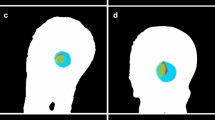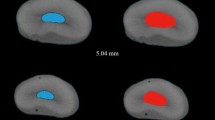Abstract
The aim of this study was to evaluate the shaping characteristics of Protaper Universal (PTU; Dentsply Tulsa Dental Specialties, Johnson City, TN), Hero Shaper (HS; MicroMega, Besacon, France) and Hyflex CM (HCM; Coltene-Whaledent, Allstetten, Switzerland) nickel–titanium systems with various apical sizes and tapers in second mesiobuccal (MB2) canal instrumentation using micro-computed tomographic imaging. A total of 27 maxillary first molars with independent patent MB2 canals were selected and randomly assigned to three groups according to the 3-dimensional morphologic aspects obtained from preoperative micro-computed tomographic scans. Canals were first negotiated with a size 8 K-file and finally prepared to F1, F2, and F3 with PTU and to sizes 20.04 taper, 25.04 taper, and 30.04 taper with HS and HCM. Postoperative scans were performed after each instrumentation with the same parameters used in the initial scan. The canal volume, canal transportation, untouched canal surface and wall thickness were measured and calculated using Mimics 10.01 software (Image Works, Materialise, Belgium). Statistical analysis was performed using one-way analysis of variance post hoc LSD tests. PTU removed more dentin than HS and HCM in all sections when instrumented to the same apical size (P < 0.05). HS and HCM presented a lower mean value of canal transportation than PTU in all measured sizes and sections. PTU presented a lower mean value of distal wall thickness than HS and HCM at the level of 1 and 2 mm below the furcation region in all measured sizes. In conclusion, for MB2 canal instrumentation, HS and HCM of 0.04 taper are safer than PTU.


Similar content being viewed by others
References
Martins JNR, Alkhawas MAM, Altaki Z, et al. Worldwide analyses of maxillary first molar second mesiobuccal prevalence: a multicenter cone-beam computed tomographic study. J Endod. 2018;44:1641–9.
Mario Luis Z, Maria Cristina C, Gustavo DD. Negotiability of second mesiobuccal canals in maxillary molars using a reciprocating system. J Endod. 2015;41:1913–7.
Shivashankar MB, Niranjan NT, Jayasheel A, et al. Computed tomography evaluation of canal transportation and volumetric changes in root canal dentin of curved canals using Mtwo ProTaper and ProTaper Next rotary system—an in vitro study. J Clin Diagn Res. 2016;10:ZC10–4.
Haupt F, Wilhelm Pult JR, Hülsmann M. Micro-CT evaluation of the shaping ability of three reciprocating single-file NiTi-systems on single- and double-curved root canals. J Endod. 2020. https://doi.org/10.1016/j.joen.2020.05.005.
Lin LM, Rosenberg PA, Lin J. Do procedural errors cause endodontic treatment failure? J Am Dent Assoc. 2005;136:187–231.
Alberton CS, Fagundes Tomazinho FS, Calefi PS, Húngaro Duarte MA, Vivan RR, Baratto-Filho F. Influence of the preparation order in 4-canals maxillary molars with WaveOne Gold system. J Endod. 2020. https://doi.org/10.1016/j.joen.2020.05.018.
Gagliardi J, Versiani MA, De Sousa-Neto MDO, et al. Evaluation of the shaping characteristics of ProTaper Gold, ProTaper NEXT, and ProTaper Universal in curved canals. J Endod. 2015;41:1718–24.
Camara AC, Aguiar CM. Evaluation of the root dentine cutting effectiveness of the HERO 642, HERO Apical and HERO Shaper rotary systems. Aust Endod J. 2008;34:94–100.
Calas P. HEROShapers®: the adapted pitch concept. Endod Top. 2005;10:155–62.
Miyai K, Ebihara A, Hayashi Y, Doi H, Suda H, Yoneyama T. Influence of phase transformation on the torsional and bending properties of nickel–titanium rotary endodontic instruments. Int Endod J. 2006;39:119–26.
Zhao D, Shen Y, Peng B, et al. Micro-computed tomography evaluation of the preparation of mesiobuccal root canals in maxillary first molars with Hyflex CM, Twisted Files, and K3 Instruments. J Endod. 2013;39:385–8.
Saber SE, Nagy MM, Schafer E. Comparative evaluation of the shaping ability of ProTaper Next, iRaCe and Hyflex CM rotary NiTi files in severely curved root canals. Int Endod J. 2015;48:131–6.
Esposito PT, Cunningham CJ. A comparison of canal preparation with nickel–titanium and stainless steel instruments. J Endod. 1995;21:173–6.
Lacerda MFLS, Marceliano-Alves MF, Perez AR, et al. Cleaning and shaping oval canals with 3 instrumentation systems: a correlative micro-computed tomographic and histologic study. J Endod. 2017;43:1878–84.
Da Silva Limoeiro AG, AnHB DS, De Martin AS, et al. Micro-computed tomographic evaluation of 2 nickel-titanium instrument systems in shaping root canals. J Endod. 2016;42:496–9.
Brasil SC, Marceliano-Alves MF, Marques ML, et al. Canal transportation, unprepared areas, and dentin removal after preparation with BT-RaCe and ProTaper Next Systems. J Endod. 2017;43:1683–7.
Zhao D, Shen Ya, Peng B, et al. Root canal preparation of mandibular molars with 3 nickel-titanium rotary instruments: a micro-computed tomographic study. J Endod. 2014;40:1860–4.
Peters OA, Arias A, Paque F. A micro–computed tomographic assessment of root canal preparation with a novel instrument, TRUShape, in mesial roots of mandibular molars. J Endod. 2015;41:1545–50.
Siqueira JF, Perez AR, Marceliano-Alves MF, et al. What happens to unprepared root canal walls: a correlative analysis using micro-computed tomography and histology/scanning electron microscopy. Int Endod J. 2018;51:501–8.
Rodrigues RCV, Zandi H, Kristoffersen AK, et al. Influence of the Apical Preparation Size and the Irrigant Type on Bacterial Reduction in Root Canal–treated Teeth with Apical Periodontitis. J Endod. 2017;43:1058–63.
Keleş A, Keskin C, Karataşlıoğlu E, Kishen A, Versiani MA. Middle Mesial Canal Preparation Enhances the Risk of Fracture in Mesial Root of Mandibular Molars. J Endod. 2020.; doi: https://doi.org/10.1016/j.joen.2020.05.019.
Schneider SW. A comparison of canal preparations in straight and curved root canals. Oral Surg Oral Med Oral Pathol. 1971;32:271–5.
Peters OA, Laib A, Göhring TN, Barbakow F. Changes in root canal geometry after preparation assessed by high-resolution computed tomography. J Endod. 2001;27:1–6.
Gambill JM, Alder M, del Rio CE. Comparison of nickel-titanium and stainless steel hand-file instrumentation using computed tomography. J Endod. 1996;22:369–75.
Chai WL, Thong YL. Cross-sectional morphology and minimum canal wall widths in C-shaped roots of mandibular molars. J Endod. 2004;30:509–12.
Elayouti A. Efficacy of rotary instruments with greater taper in preparing oval canals. Int Endod J. 2010;41:1088–92.
Wilcox LR, Roskelley C, Sutton T. The relationship of root canal enlargement to finger-spreader induced VRF. J Endod. 1997;23:533–4.
Versiani MA, Pecora JD, Sousa-Neto MD. The anatomy of two-rooted mandibular canines determined using micro-computed tomography. Int Endod J. 2011;44:682–7.
Davis RD, Marshall JG, Baumgartner JR. Effect of Early Coronal Flaring on Working Length Change in Curved Canals Using Rotary Nickel-Titanium Versus Stainless Steel Instruments. J Endod. 2002;28:438–42.
Siqueira IG, Machado BJ, Alexandre C, et al. Influence of cervical preflaring on apical file size determination in maxillary lateral incisors. Brazilian Dental Journal. 2007;18:102–6.
Plotino G, Venkateshbabu N, Bukiet F, et al. Influence of negotiation, glide path, and preflaring procedures on root canal shaping—terminology, basic concepts, and a systematic review. J Endod. 2020;46:707–229.
Otavio JFDAR, Leonardi DP, Gabardo MCL, et al. Influence of Cervical and Apical Enlargement Associated with the WaveOne System on the Transportation and Centralization of Endodontic Preparations. J Endod. 2016;42:626–31.
Fogarty TJ, Montgomery S. Effect of preflaring on canal transportation. Evaluation of ultrasonic, sonic, and conventional techniques. Oral Surg Oral Med Oral Pathol. 1991; 72:345–50.
Barbieri N, Leonardi DP, Baechtold MS, Correr GM, Gabardo MC, Zielak JC, Baratto-Filho F. Influence of cervical preflaring on apical transportation in curved root canals instrumented by reciprocating file systems. BMC Oral Health. 2015;15:149.
Markvart M, Darvann TA, Larsen P, et al. Micro-CT analyses of apical enlargement and molar root canal complexity. Int Endod J. 2012;45:273–81.
Peru M, Peru C, Mannocci F, et al. Hand and nickel-titanium root canal instrumentation performed by dental students: a micro-computed tomographic study. Eur J Dent Educ. 2010;10:52–9.
Yang G, Yuan G, Yun X, et al. Effects of two nickel-titanium instrument systems, Mtwo versus ProTaper Universal, on root canal geometry assessed by micro-computed tomography. J Endod. 2011;37:1412–6.
Wu MK, Fan B, Wesselink PR. Leakage along apical root fillings in curved root canals. Part I: effects of apical transportation on seal of root fillings. J Endod. 2000;26:210–6.
Mohammadi Z, Palazzi F, Giardino L, Shalavi S. Microbial biofilms in endodontic infections: an update review. Biomed J. 2013;36:59–70.
Paque F, Zehnder M, De-Deus G. Microtomography-based comparison of reciprocating single-file F2 ProTaper technique versus rotary full sequence. J Endod. 2011;37:1394–7.
Gergi R, Osta N, Bourbouze G, et al. Effects of three nickel titanium instrument systems on root canal geometry assessed by micro-computed tomography. Int Endod J. 2015;48:162–70.
Versiani MA, Leoni GB, Steier L, et al. Micro–computed tomography study of oval-shaped canals prepared with the self-adjusting file, Reciproc, WaveOne, and ProTaper Universal systems. J Endod. 2013;39:1060–6.
Peters OA, Laib A, Gohring TN, et al. Changes in root canal geometry after preparation assessed by high-resolution computed tomography. J Endod. 2001;27:1–6.
Paque F, GanahlPeters DOA. Effects of root canal preparation on apical geometry assessed by micro-computed tomography. J Endod. 2009;35:1056–9.
Htun PH, Ebihara A, Maki K, Kimura S, Nishijo M, Okiji T. Cleaning and shaping ability of Gentlefile, HyFlex EDM, and ProTaper next instruments: a combined micro-computed tomographic and scanning electron microscopic study. J Endod. 2020;46:973–9.
Acknowledgements
The authors deny any conflicts of interest related to this study. This research was funded by the Priority Academic Program Development of Jiangsu Higher Education Institutions (PAPD_2018-87), Natural Science Foundation of Jiangsu Province (BK_20191347), General Project of the Science and Technology Development Fund of Nanjing Medical University (project number: NMUB2018168) and Natural Science Foundation of Nanjing (201803045).
Author information
Authors and Affiliations
Corresponding authors
Ethics declarations
Conflict of interest
The authors deny any conflicts of interest related to this study.
Additional information
Publisher's Note
Springer Nature remains neutral with regard to jurisdictional claims in published maps and institutional affiliations.
Yuerong Zhang and Jie Liu are contributed equally to this work.
Guangdong Zhang and Hai Xu are co-corresponding author.
Rights and permissions
About this article
Cite this article
Zhang, Y., Liu, J., Gu, Y. et al. Analysis of second mesiobuccal root canal instrumentation in maxillary first molars with three nickel–titanium rotary instruments: a micro-computed tomographic study. Odontology 109, 496–505 (2021). https://doi.org/10.1007/s10266-020-00564-2
Received:
Accepted:
Published:
Issue Date:
DOI: https://doi.org/10.1007/s10266-020-00564-2




